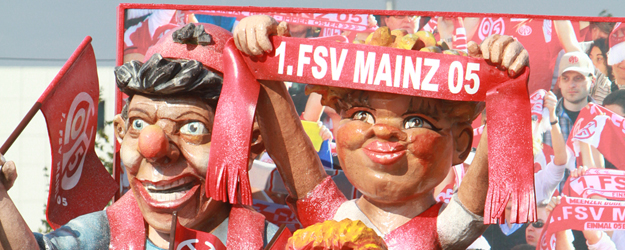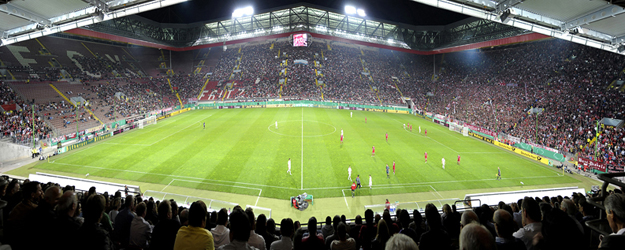17 July 2012
What form does regional identity take in an increasingly globalized world? This was the subject of the inaugural lecture of cultural anthropologist Dr. Christina Niem. Her talk was entitled "Regional representation or competing regional identities? Two Rhineland-Palatinate Bundesliga soccer teams in comparison", and she used it to provide an analysis of 1. FSV Mainz 05, 1. FC Kaiserslautern, and their fan clubs.
The venerable "Meenzer Schwellköpp" lead the procession followed by other carnival clubs, while even themed floats are in on the party. It definitely has the feel of a Shrove Monday carnival parade. But it is actually a soccer team on the move. On July 3, 2011, 1. FSV Mainz 05 officially relocated from its old Bruchweg Stadium to its new home in the Coface Arena.
"The team has reinvented itself as a sort of shrovetide club," explains Dr. Christina Niem when commenting on the images. "It is an expression of uniqueness, an evocation of regional identity." In her inaugural lecture for the acquirement of the venia legendi in Cultural Anthropology/Folklore Studies at the Department of Film, Theater, and Empirical Cultural Studies at Johannes Gutenberg University Mainz (JGU), Niem considered the 1. FSV Mainz 05 and 1. FC Kaiserslautern soccer teams and, in particular, their fan clubs. She gave her talk in the Faculty Hall of the Philosophicum building under the title "Regional representation or competing regional identities? Two Rhineland-Palatinate Bundesliga soccer teams in comparison".
A Mainz supporter in the auditorium
"'Is it gonna be boring?' my son asked me. 'I'm going to talk about soccer', I answered. 'Then I'll come.'" So he is now also in the auditorium. Tilman, a ten-year-old red head, is sitting there in a red-white Mainz 05 soccer shirt with "Schürrle" printed on the back. "We expect him to interrupt if she gets anything wrong," whispers a relative. As it turns out, however, Tilman keeps quiet. Mom one, Tilman nil.
"What is the significance of homeland and region in a globalized world?" asks Niem. "Have individualization and mobility caused the ties to a specific place to become obsolete?" It seems, however, that this is not actually the case. "There are times when strong regional attachments come to the fore. People counter insecurity in their lives by forming ties to their physical homeland." At the end of the 19th century, for example, the educated bourgeoisie began to express an interest in their homeland and their indigenous culture, and this was accompanied by a disdain for city life and a romanticizing of the rural.
Our Poldi – a regional novel
"Nowadays the longing for local identity, for local heroes appears to have become dominant once again," says Niem. Thus the leader article of the April 2011 issue of the soccer magazine 11 Freunde was entitled "Uns Poldi – ein Heimatroman" ("Our Poldi – a regional novel"), and it looked at the career of Lukas Podolski who grew up in Cologne. "He went out into the world (and joined Bayern Munich) only to return home (to play for 1. FC Cologne), where he became leader," is how Niem summarizes his story. However, it seems he decided to go back back out into the world when he signed for Arsenal London. "So is Poldi a soccer mercenary?"
A week after her inaugural lecture, Niem sits in her office in the Philosophicum building. The glorification of soccer players as regional heroes is something that she has also witnessed in Mainz. In our era of globalization, the actual origins of a player are not all that important. Aristide Bancé, born in Ivory Coast, was quickly adopted as an honorary Mainz local when he started scoring goals for his club. "What is happening is that things are being linked that do not, at first glance, appear to be related."
Flehlabbe and beKloppte
But let’s return to her lecture. Homeland and region are very important to soccer fans. In Mainz, this concept is manifested in the way that the soccer club has joined forces with the shrovetide festival associations. Even the insult once leveled at them by opposing fans has become the battle cry of the Mainz supporters – "We're just a carnival club! "
The names used by the Mainz 05 fan clubs also indicate an underlying regional allegiance. There are now 225 of these and although the majority is based in Mainz itself, which alone has 92, there are 65 in Rhinehessen and 20 in the other regions of Rhineland-Palatinate, while there are even two in Berlin. Dialect plays an important role in many of these. They have names like "Meenzer Flehlabbe", "Anner Rhoiseit" and "Mer gehen (n)immer ruff". They also use regional designations in their names, such as the "05er im Schatten des Doms" and "Bruchweg Sehnsucht", used by exiled supporters in Berlin to express their love of the old Mainz 05 stadium. And, of course, there are those who choose to honor their hero, ex-trainer Jürgen Klopp by calling themselves "Die beKLOPPten".
Five and the "Miracle of Bern"
1. FC Kaiserslautern has about 400 fan clubs. They employ conceits similar to those used by the Mainz clubs when it comes to finding names. "But the Kaiserslautern supporter clubs are much more widely spread in geographical terms," explains Niem. The club has been in the Bundesliga much longer than Mainz 05, and it also played a special role in the "Miracle of Bern". Fritz Walter and four other members of the Kaiserslautern club were playing for the German national team when it won the World Cup Final in Bern, Switzerland in 1954.
FC Kaiserslautern and its fans still identify with their region much in the same way as the Mainz 05 supporters, but non-regional aspects play a greater role here. The Betze, the club's Betzenberg Stadium, has a memorial to the Kaiserslautern players who triumphed in Bern.
15-0 to 1. FC Kaiserslautern
"The differences in terms of playing skill have long played a role in the rivalry between the two clubs," states Niem. "This meant that Kaiserslautern was perceived as top dog in comparison with Mainz." The historic results back her up – in 1945, Kaiserslautern beat Mainz 15-0. "But the boot has been on the other foot more recently. There has been a complete reversal of the historical roles." Mainz plays in the Bundesliga and Kaiserslautern is now second division.
"My inaugural lecture was on July 4th, the same day as the World Cup final in Bern," notes Niem later in her office with a smile. She once again shows her presentation on the PC: The shrovetide-like procession of Mainz 05 to its new home, team lists of names, pictures of fans, and much more. But aren't these very unusual subjects for academic research?
A focus on people
By way of reply, Niem invokes the founding fathers of folklore studies. "Jacob and Wilhelm Grimm were interested in the common culture of the people." They collected legends and fairy tales. Jacob then had to face the accusations of a contemporary who accused him of "devotion to the insignificant".
"So I actually think I'm in pretty good company," says the folklorist. "I want to understand how people integrate the phenomena of soccer in their daily lives. I am interested in finding out what this actually means to people. In my work, I focus on people."



